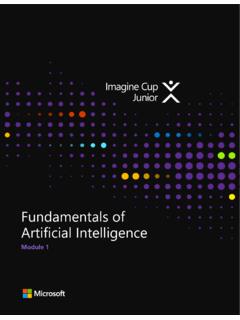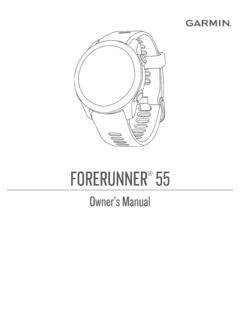Transcription of Industry 4.0 and manufacturing ecosystems - Deloitte
1 Industry and manufacturing ecosystems Exploring the world of connected enterprisesThe authors would like to thank Steve Shepley and Alan Brady, both of Deloitte Consulting LLP, for their contributions to this article. Brenna SnidermanBrenna Sniderman is a senior manager with Deloitte Services LP, affiliated with Deloitte s Center for Integrated Research. Her research focuses on issues related to the application of advanced tech-nologies in manufacturing and their impact on business growth. Monika MahtoMonika Mahto is an assistant manager with Deloitte Services India Pvt. Ltd and a member of Deloitte s Eminence Center of Excellence.
2 Over the last seven years, she has been involved in research focused on the strategic implications of advanced technologies related to manufacturing and consumer products industries. Mark J. CotteleerMark J. Cotteleer is a research director with Deloitte Services LP, affiliated with Deloitte s Center for Integrated Research. His research focuses on operational and financial performance improvement, in particular, through the application of advanced the authorsDeloitte Consulting LLP s Supply Chain and manufacturing Operations practice helps companies understand and address opportunities to apply Industry technologies in pursuit of their business objectives.
3 Our insights into additive manufacturing , IoT, and analytics enable us to help organizations reassess their people, processes, and technologies in light of advanced manufacturing practices that are evolving every and manufacturing ecosystems ContentsIntroduction | 2 From the old world to the new | 4 Defining Industry the digital and the physical to achieve business objectives | 9 Growing the business | 11 Applying Industry to build revenue Operating the business | 14 Using Industry technologies to increase productivity and reduce riskLooking ahead | 17 Conclusion | 19 Endnotes | 20 Exploring the world of connected enterprises1
4 IntroductionMANUFACTURERS face changes on multiple fronts. Advanced manufac-turing in the form of additive manufactur-ing, advanced materials, smart, automated machines, and other technologies is usher-ing in a new age of physical At the same time, increased connectivity and ever more sophisticated data-gathering and analytics capabilities enabled by the Internet of Things (IoT) have led to a shift toward an information-based economy. With the IoT, data, in addition to physical objects, are a source of value and connectivity makes it possible to build smarter supply chains, manufacturing processes, and even end-to-end As these waves of change continue to shape the competitive landscape, manufacturers must decide how and where to invest in new tech-nologies, and identify which ones will drive the most benefit for their organizations.
5 In addi-tion to accurately assessing their current stra-tegic positions, successful manufacturers need a clear articulation of their business objectives, identifying where to play in newly emerging technology ecosystems and (as important) what are the technologies, both physical and digital, that they will deploy in pursuit of deci-sions they make about how to charge is perhaps easier to execute in theory than in practice. Despite the hype around advanced digital and physical tech-nologies, many are not Likewise, many stakeholders are unclear as to what all this connectivity means for their companies and for the broader manufacturing One thing is certain, however: It would be folly to underestimate the crucial role the flow of information plays in the physical aspects of advanced manufacturing .
6 In order to fully realize the opportunities both of these domains present, it is crucial to integrate the two use While Deloitte refers to smart, connected manufacturing as Industry , several other commonly known terms may point to the same phenomenon. These include: Industrial Internet connected Enterprise SMART manufacturing Smart Factory manufacturing Internet of Everything Internet of Things for manufacturing INDUSTRIE connects embedded system production technologies and smart production processes to pave the way to a new technological age which will radically transform Industry and production value chains and business models.
7 Germany Trade and Invest1 Industry and manufacturing ecosystems 2the digital information from many different sources and locations to drive the physical act of manufacturing . In other words, integrate information technology (IT) and operations technology (OT) to forge a stronger manu-facturing organization a state that we and others refer to as Industry Also known as SMART manufacturing or manufacturing , Industry is marked by a shift toward a physical-to-digital-to-physical this report, we offer a perspective to help manufacturers navigate toward an Industry future.
8 We do so by examining the flow of information in intelligent production and connected supply chains that is, systems that inform and coordinate the manufacturing , dis-tribution, and aftermarket process through the lens of Deloitte s Information Value Loop (IVL). We then review the impact of the IVL on the manufacturing value chain. In the remainder of this article we will: Explain the term Industry , its history, and the expanding breadth of the concept Review the fundamentals of Deloitte s IVL framework and its relation to Industry Identify two strategic areas growing the business and operating the business and six transformational plays that encompass the core opportunities for manufacturers to create with Industry technologies Uncover key challenges for Industry deploymentsExploring the world of connected enterprises3 ROOTED in the notion that the swarm of connected .
9 Smart technologies could marry and thus revolutionize production, the term Industry encompasses a promise of a new industrial revolution, the fourth such transformation in the history of manufacturing (see figure 1 for a summary of the industrial revolutions).8 The definition for Industry was first introduced in 2011 at the Hannover Messe trade fair, and was the subject of an Industry working group established by the German federal Germany Trade and Invest (GTAI) defines Industry as:A paradigm shift .. made possible by technological advances which constitute a reversal of conventional production process logic.
10 Simply put, this means that industrial production machinery no lon-ger simply processes the product, but From the old world to the newDefining Industry Graphic: Deloitte University Press | industrial revolution: Power generation Introduction of the power loom in 1784 Mechanization of production facilities with water and steam powerLate 18th centuryBeginning of 20th century1970s 2000s2010 onwardSecond industrial revolution: Industrialization Introduction of the assembly line in slaughterhouses in 1870 Electrification drives mass production in a variety of industriesThird industrial revolution: Electronic automation Development of the first programmable logic controller (PLC) in 1969 Growing application of electronics and IT to automate production processesFourth industrial revolution.














